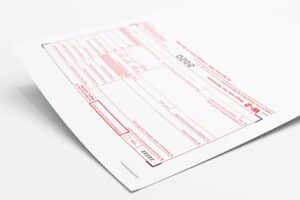And Why You Won’t Use a 1099-MISC in 2020
As a small business owner, it’s not uncommon to hire out work to a third party. When these third parties are independent contractors, and you pay them $600 or more for products or services, the IRS requires you to fill out a 1099 form as well as create a 1099 pay stub. 1099 pay stubs are critical for both budgeting and tax purposes.
What is a 1099?
 A 1099 form is a tax information form used by the IRS to track various transactions. For example, a 1099-A Form is used when real estate transactions take place, 1099-DIV is filled out when dividends are paid to investors — There’s even a 1099-C that’s used if the government cancels debt.
A 1099 form is a tax information form used by the IRS to track various transactions. For example, a 1099-A Form is used when real estate transactions take place, 1099-DIV is filled out when dividends are paid to investors — There’s even a 1099-C that’s used if the government cancels debt.
The most common 1099 form (up until 2020) was the 1099-MISC because it’s the form used when businesses paid contractors — something that happens a lot. On that form, it was reported as “Non-Employee Compensation” in box 7.
The IRS made a change in 2020. Now, there is a specific form for reporting non-employee compensation — The 1099-NEC. For the 2020 tax year, the IRS now requires a 1099-NEC form to be used for general non-employment compensation reporting.
1099 Misc vs 1099 NEC
If you were used to the old 1099-MISC forms, don’t worry; the NEC works the same way, and it’s actually much simpler. On the old 1099-MISC form, box 7 reported non-employee compensation, in between a myriad of other tiny boxes that were irrelevant if you were simply paying a contractor.
Filling out the new 1099-NEC form is simple. Essentially, input your business information, the contractor’s information, how much you paid them, and anything you withheld. The NEC cuts through the clutter and makes paying contractors and non-employees much easier.
Difference between a 1099 MISC and 1099 NEC as of 2020:
1099 MISC
- Used for Miscellaneous payments, ranging from rents to fishing boat proceeds to golden parachute payments.
- No longer the form used for payments made to independent contractors
1099 NEC
- Simplified form
- Single-purpose, to report payments to non-employees (i.e. independent contractors)
- Required for reporting contractor payments as of the 2020 tax year.
How To Fill Out a 1099 NEC
W-9 Forms
Before you allow a contractor to complete any services, the 1099 employee needs to fill out the W9 form. The W9 is crucial because it has the information of the contractor that you will use while filling out 1099s.
The contractor will provide their taxpayer identification number (TIN) as well as their business or personal contact information. The TIN can be either a number assigned to their business or their personal social security number.
Order forms, or set up your software
Once the contract work has been completed and you have paid the contractor, you need to send them their 1099-NEC. There are three copies of the 1099: Copy A, Copy B, and Copy C. If you are filing on paper, you must order official versions of copy A. You can’t simply download the file from the internet and print it off, as this won’t work with the IRS document scanners.
Copy B, which goes to the contractor so they can file their tax return, can be downloaded from the internet, no special paper needed. Same goes for copy C, which is for your own record keeping.
If you are filing through the IRS’s online filing system, you won’t need to order the official documents, but if you want to handwrite your 1099s you’ll need to order the forms from the IRS or another supplier.
Filling out a 1099 Form
- Filling out Payer and Recipient Information
This is where the W-9 you collected earlier comes in. Transfer the contractor’s TIN and contact information under “Recipient TIN” and “Recipient Name.” The address field is the address of the contractor, not your business. Input your own TIN under “payer TIN.” If you did your due diligence in collecting a W-9 from the independent contractor, this is a simple step.
- Compensation and Tax Withholding
Input the amount paid to the independent contractor under “nonemployee compensation.” 1099s are only required if you are paying more than $600 to the non-employee.
The following boxes only apply if you are going to withhold taxes on behalf of the contractor. This is uncommon, but works in the same way as withholding employee taxes from their paychecks.
- Send Copy A to the IRS
If filing on paper, mail your official (not downloaded from the internet and printed off) copy A of the 1099 form. You can handwrite your 1099 copy A if filing on paper, just make sure it’s on an official purchased form. If submitting electronically, simply go through the IRS online submission tool and send it that way.
- Send Form 1096 to the IRS
If you are filing on paper, remember to submit Form 1096 to the IRS along with the 1099. Form 1096 simply lists the various kinds of information returns, and you indicate in checkboxes which forms you are sending them. If you are only sending a 1099-NEC or MISC, simply check that box before enclosing and sending that form. Form 1096 helps the IRS double check that they have received all necessary forms and nothing slips past their attention.
- Send Copy B to the Independent Contractor
Copy B can be downloaded and printed off — no need to purchase an official form from a supplier. This is just going to be used by the independent contractor for information while they do their taxes the following year.
- Store Copy C for your records.
It’s always a good idea to hang on to your copy of 1099s you’ve paid out. That way, if the contractor loses theirs or the IRS comes knocking, you’ll have all the necessary information on file.
Deadlines
1099s are like W2s — the deadline for sending them to the independent contractor is January 31st of the applicable tax season. Make sure and get copy B to the contractor or you’ll potentially face serious fines. The IRS requires copy A to be sent to them by the last day of February if filing on paper, or March 31st if you are going to use the IRS online system.
These due dates are important! You could face fines of up to $500,000 a year if you neglect to file your company’s 1099s.
Conclusion
Tax code is complex, but filling out a 1099 is simple! As long as you stay aware of deadlines and make sure you keep the right records on file, you’ll be safe from any penalties and will maintain consistent relationships with your independent contractors. With Check Stub Maker, creating a 1099 pay stub is even easier than ever! Click here to build your 1099 pay stub today!



